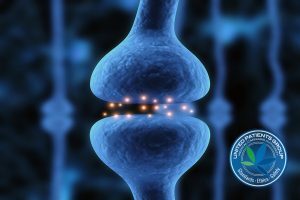Article Topics
The Endocannabinoid System
 There’s a physiologic system found in all vertebrates – and sea quirts and nematodes – named after cannabis: the endocannabinoid system. According to Dr. Dustin Sulak, “the endocannabinoid system may be the most important physiologic system involved in establishing and maintaining human health.” What is the endocannabinoid system, and what does it do that is so important for our health?
There’s a physiologic system found in all vertebrates – and sea quirts and nematodes – named after cannabis: the endocannabinoid system. According to Dr. Dustin Sulak, “the endocannabinoid system may be the most important physiologic system involved in establishing and maintaining human health.” What is the endocannabinoid system, and what does it do that is so important for our health?
In the 1980s, cannabis researchers discovered a receptor in the brain and central nervous system that he named CB1. This receptor, cannabinoid receptor one, appeared to exist specifically to receive the phytocannabinoid THC. This seemed unlikely, though. Researchers shifted their focus to looking for endogenous chemicals that act on the CB1 receptor: endocannabinoids. The very first endocannabinoid that researches observed bonding to the CB1 receptor was a receptor called anandamide. Also known as the bliss compound, anandamide stimulates sensations of joy and happiness. Though anandamide has a different chemical structure than THC, it nonetheless bonds to the CB1 receptor. Anandamide even exhibits the same effects as THC, though to a lesser degree.
Researchers later found another cannabinoid receptor, CB2, most commonly found in the membranes of immune cells and immune tissue and organs like the spleen, bone marrow and tonsils. Other cannabinoids, like the phytocannabinoids, cannabidiol and cannabinol, and endocannabinoids like anandamide and 2-Arachidonoylglycerl (2-AG), act on these receptors.
Endocannabinoids and Homeostasis
So what does the endocannabinoid system do? We know that it’s one of the biggest contributors to homeostasis. Homeostasis is the “tendency toward a relatively stable equilibrium between interdependent elements, especially as maintained by physiological processes.” Cannabinoids help regulate homeostasis at every level of life, from sub-cellular levels to the organism itself.
“tendency toward a relatively stable equilibrium between interdependent elements, especially as maintained by physiological processes.” Cannabinoids help regulate homeostasis at every level of life, from sub-cellular levels to the organism itself.
One interesting way that endocannabinoids differ from other neurotransmitters is that they transmit information in retrograde. This means that instead of traveling from the presynaptic neuron to the postsynaptic, they can flow the opposite way. In doing so, endocannabinoids can provide feedback to the nervous system. For example, endocannabinoids will travel “upstream” to inform presynaptic neurons when a neuron is firing too quickly.
“At the site of an injury, for example, cannabinoids can be found decreasing the release of activators and sensitizers from the injured tissue, stabilizing the nerve cell to prevent excessive firing, and calming nearby immune cells to prevent release of pro-inflammatory substances. Three different mechanisms of action on three different cell types for a single purpose: minimize the pain and damage caused by the injury,” says Dr. Sulak.
Research suggests that we can enhance the endocannabinoid system by supplementing with exogenous cannabinoids. Exogenous  cannabinoids can help regulate homeostasis, because we already have the organic infrastructure in place to receive them. For example, when THC connects with the endocannabinoid system, it provides highly effective pain relief. The THC modulates neurological function to reduce pain signals. Likewise, THC, when connected to the endocannabinoid system, can send malignant cells into apoptosis. The cellular process of autophagy is moderated by the endocannabinoid system. Autophagy not only keeps healthy cells alive, but also causes malignant cancer cells to consume themselves.
cannabinoids can help regulate homeostasis, because we already have the organic infrastructure in place to receive them. For example, when THC connects with the endocannabinoid system, it provides highly effective pain relief. The THC modulates neurological function to reduce pain signals. Likewise, THC, when connected to the endocannabinoid system, can send malignant cells into apoptosis. The cellular process of autophagy is moderated by the endocannabinoid system. Autophagy not only keeps healthy cells alive, but also causes malignant cancer cells to consume themselves.
Dr. Sulak agrees that cannabis can help us prevent disease and promote health by activating the endocannabinoid system. He says, “Research has shown that small doses of cannabinoids from cannabis can signal the body to make more endocannabinoids and build more cannabinoid receptors.” This could explain why so many people don’t feel the effects of cannabis the first time they use it. “More receptors increase a person’s sensitivity to cannabinoids; smaller doses have larger effects, and the individual has an enhanced baseline of endocannabinoid activity. I believe that small, regular doses of cannabis might act as a tonic to our most central physiologic healing system.”
The Endocannabinoid System, Cannabis and the Future
It’s important to recognize that study of this ancient system within all of us has only just begun. For example, many researchers suspect the existence of a third cannabinoid receptor yet to be discovered. We do know that the cannabis plant employs its cannabinoids to maintain its own health and immune system. That’s right – just as cannabinoids help prevent disease in humans, they perform that function in the cannabis plant as well. This is because cannabinoids have antioxidant properties that neutralize free radicals that ultraviolet radiation generate. Free radicals are responsible for aging-related illnesses in humans, including cancer.
Dr. Robert Melamede, former chair of biology at CU Colorado Springs, suggests that cannabinoids can even affect politics. The endocannabinoid system is largely responsible for controlling the process of neurogenesis: the regeneration of nerve cells. Neurogenesis is involved with neuronal plasticity and learning. In a paper published by NECSI Dr. Melamede says, “It is hypothesized that people with an endocannabinoid deficiency in critical areas of the brain will tend to look backwards in time because that view minimizes the need for re-learning. Conversely, a robust endocannabinoid system equips an individual to adjust to the future by controlling the reformulation of old memories and patterns of behavior as new learning dictates.”
involved with neuronal plasticity and learning. In a paper published by NECSI Dr. Melamede says, “It is hypothesized that people with an endocannabinoid deficiency in critical areas of the brain will tend to look backwards in time because that view minimizes the need for re-learning. Conversely, a robust endocannabinoid system equips an individual to adjust to the future by controlling the reformulation of old memories and patterns of behavior as new learning dictates.”
Of course, any given population will have a spectrum of endocannabinoid activity. There are many implications of this. “Individuals with a relative endocannabinoid deficiency in critical areas of the brain will have a greater tendency to agree with one and other because they have a greater probability of looking into the past and trying to preserve the status quo. In contrast, individuals endowed with an above average endocannabinoid system can better adjust to the novelty of a developing situation. The greater tendency for conservative consensus will tend to give the cannabinoid deficient population greater political power,” says Dr. Melamede.
This has weighty implications. If true, the same people with endocannabinoid deficiencies are the same people who are passing anti-cannabis legislation. As Dr. Melamede says, “The biological activity of cannabinoids goes against their genetics.” Could this partially explain why the FDA claims that marijuana has no medical benefits, despite mounting clinical and anecdotal evidence? Could it be “evolution in action?”
One thing is certain: we can expect extensive study of cannabinoids and the endocannabinoid in the near future.






































